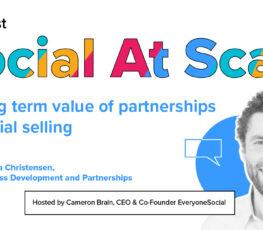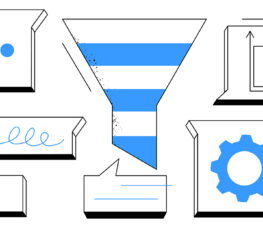Content is content — as long as you’re producing it and they’re reading it, who cares what it’s about, right? Wrong.
Your content should always be created with a strategic purpose in mind: to describe, entertain, inform, or persuade.
But why should sales enablement content be important to you? Isn’t making sales the job of, well, the sales team?
I mean, yeah, but I bet they’d REALLY like your help in doing that.
Besides, content that helps the sales team close more deals actually winds up benefiting pretty much every other department, anyway.
Before I get to that, however, we have some other stuff to cover. Stuff like…
What Is Sales Enablement Content?
…and how is it different from other kinds of content, specifically?
Admittedly, there can be a lot of overlap — particularly with marketing content. It mostly comes down to how and why you’re presenting the information.
For example, marketing content is written for the express purpose of generating interest or attracting attention from your target audience.
On the flip side, the strategy for sales enablement content is to finish the process that your marketing content started.
Sales content is also created to meet the reader exactly where they are in the buyer’s journey (or if you’d prefer, the “sales funnel”).
That means that a blog post targeting the awareness stage — the top of your funnel — will have a slightly different feel than a case study or how-to guide that’s geared toward the later stages.
Hubspot has a wonderfully concise sales enablement definition: “It is the iterative process of providing your business’s sales team with the resources they need to close more deals.”
Those resources are often based on documentation created by engineering or client success teams, and they fall into two main categories: internal or external.
Internal sales enablement content generally includes:
- Product demonstration scripts
- Presentation decks
- Buyer personas
- Whitepapers
External sales enablement content can closely resemble marketing content and often taking the form of:
- How-to or product-comparison blog posts
- Case studies
- Customer stories and testimonials
- Email distribution campaigns
- Short-form video
Also, I’m speaking from experience when I say you should base your sales enablement content on internal documentation!
Writing about new platform features is made SO much easier by referencing our engineers’ detailed notes that cover exactly how everything works.
Why Does Sales Enablement Content Matter?
The benefits for your sales and marketing teams are pretty self-explanatory; after all, “tightly aligned sales and marketing operations achieved 24% faster three-year revenue growth.”
“For me to do my job well, I need to be on the same page as the sales team.” – Megan Stewart, Enterprise Customer Success Manager at EveryoneSocial
That’s one of the reasons that our marketing team here at EveryoneSocial regularly convenes with the sales folks to discuss customer pain points and improve our sales enablement strategy.
These discussions help us reach our audience with the information they need, and help sales increase the quality of their leads. They just make everyone’s job easier!
“This all sounds great, but still — why should I care?”
I did just say everyone’s job, didn’t I? A high-performing sales team impacts everyone else down the line.
As a company continues acquiring new customers, other departments like product, customer success, implementation, and engineering usually all see expansion. After all, someone has to take care of those new clients!
The Best Types of Sales Enablement Content
In addition to what we listed earlier, here are a few more pieces of sales enablement content you’ll want in your sales arsenal:
- Competitor analyses and product information
- Market research
- Case studies, customer stories, customer quotes
- eBooks and other detailed guides
- One-pagers with scannable information
- Internal sales training materials
- Company product and service sheet
- Content for social media, such images, gifs, and video do well
- Data, statistics, and reviews
- Podcast episodes that positively reinforce your brand
Ultimately, your audience will benefit from better sales content too since it’s created to meet them wherever they are in the buyer’s journey.
In fact, 95% of B2B buyers choose a solution provider that “provided them with ample content to help navigate through each stage of the buying process.”
If you provide these folks with interesting and relevant insights about your product, they’ll stick around.
What Are My Options For Sales Enablement Platforms?
There are many, many options you can choose from when deciding which sales enablement software to use. You might opt for using multiple platforms concurrently, and if that’s what will best meet your needs…go for it.
Clearly, we can’t NOT promote EveryoneSocial, since it’s our own product. Besides that, our platform is great for social selling — just read this if you don’t believe me!
That being said, in the interest of fairness, here are some other popular sales enablement platforms:
- Hubspot
- Outreach.io
- Highspot
- Seismic
- Guru
How Do I Build A Sales Enablement Content Strategy?
Now that we’ve covered what sales enablement content is and why it matters, it’s time to get started. Here’s a short list of steps you can take to get the ball rolling.
1. Open the lines of communication.
One of the first things you’ll want to do is establish who’s responsible for planning and implementing your sales content.
Is it one person, as part of a larger content team? Is it a whole team? Well, that’s really up to you.
One solution we’d suggest is to start by creating a cross-functional Slack or Microsoft Teams channel, if your organization uses either of those tools.
Another option is to create a new group within your employee advocacy platform. It just so happens that we know of one with some pretty slick Slack and Teams integrations…
(Just so we’re clear, I am indeed referring to EveryoneSocial.)
Like I mentioned earlier, consider creating a recurring internal meeting between sales and any other relevant departments. Let the sales team tell you exactly what they need!
“To create effective sales enablement content, you need to talk to your sales team, to your customer success team, and to customers themselves. Ask about their pain points and what questions or concerns they repeatedly encounter. This is often how some of the most valuable content is created.” – Laura Moss, Sr. Content Marketing Manager at EveryoneSocial
2. Audit your existing content & create new content.
What do you already have that can be repurposed to function as sales enablement content? Is it organized and easily accessible?
Appropriately categorize your content based on what stage of the buyer’s journey/sales funnel it’s targeting: awareness, consideration, or conversion/purchasing.
Make sure that things like sales email templates are standardized (and customer-centric), blog posts are SEO-optimized, case studies are current (and accurate), etc.
Plan your future sales enablement strategy with input from the meetings you have with sales to ensure that you’re able to meet their needs.
Look into diversifying the kind of content you’re producing! Have you considered a video case study? How about a blog where you interview a long-time customer about why they’ve stuck around?
3. Ensure your sales team is effectively equipped to USE your content.
This is one of the most important parts of the process. If the people you’re creating all this stuff for don’t know what to do with it, it doesn’t do anyone any good.
Look into using a sales enablement platform if you’re not already. When you choose one, make sure your team knows it inside and out.
Host training meetings to discuss what kind of sales enablement content they should target their pipeline with. Run through practice calls using new product one sheets, or show them where to find the newest email templates.
The great thing about most modern organizations is that these things can all be done via video conferencing or screen recording.
In other words, you don’t necessarily have to fill up your sales team’s calendar with training sessions — just make the training resources readily available!
4. Track content performance and report your findings.
Talking about the analytics of different kinds of content to see what’s helping drive lead generation and conversion is crucial.
If you don’t regularly check what’s performing well and adjust accordingly, you’re missing out on key insights that can drive business!
A lot of the guesswork is taken out when you use sales enablement platforms, like the ones listed above, since they track this stuff for you.
You’re able to know exactly which emails people are (or aren’t) opening, which blog posts regularly funnel demo requests to the team, and so on. So consider sales enablement software.
Supercharging Your Sales Enablement Strategy
Throughout this article, you’ll have noticed that I repeatedly suggest using EveryoneSocial as part of your sales enablement efforts. That’s for good reason.
First, I’ll just share these three stats:
- You’re 7x more likely to close on leads generated through social selling
- Sales reps who use social media as part of their technique outsell 73% of their peers
- 67% of consumers surveyed say they are likely to purchase an item or service they see on their social feeds.
In other words, our platform can help streamline your organization’s content sharing strategy AND boost engagement, both of which pay off big for sales teams.
















